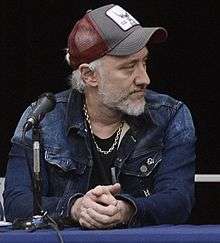Telefe
Telefe (acronym for Televisión Federal) is a television station located in Buenos Aires, Argentina. The station is owned and operated by ViacomCBS through Televisión Federal S.A.[1] Telefe is also one of Argentina's six national television networks. Its studios are located on Martínez, Buenos Aires, adjacent to the corporate headquarters;[3] its transmitter is located at the Alas Building.[4]
.png) | |
| Buenos Aires Argentina | |
|---|---|
| Channels | Analog: 11 (VHF) Digital: 34 (UHF) (Buenos Aires only) |
| Branding | Telefe |
| Slogan | Siempre juntos (Always together) |
| Programming | |
| Subchannels | (see article) |
| Ownership | |
| Owner | ViacomCBS Networks Americas[1] (Televisión Federal S.A.[2]) |
| History | |
| First air date |
|
| Technical information | |
| ERP | 150 kW |
| Transmitter coordinates | 34°35′57″S 58°22′13″W |
| Links | |
| Website | telefe |
| Type | Television network |
|---|---|
| Branding | Telefe |
| Country | |
| Availability | National and international[lower-alpha 1] |
| Founded | January 15, 1990 (30 years ago) |
| Headquarters | Cuyo 1844, Martínez, Buenos Aires[3] |
Broadcast area | Argentina |
| Parent | ViacomCBS Networks Americas |
Key people | |
Official website | telefe |
| Language | Spanish |
In areas of Argentina where a Telefe station isn't receivable over-the-air, it is available on satellite and select cable systems. Telefe also has an international network (Telefe Internacional) which is available in the Americas, Europe, Asia, and Oceania.[5]
History
First years (1957–73)
The history of Telefe stretches back to 1957, when a group of alumni and lawyers from the Colegio El Salvador led by Fr. Héctor Grandetti, founded the company Difusión Contemporánea S.A. (Contemporary Broadcasting S.A.). This company, known as DiCon for short, submitted a bid in the licensing of two new television channels in Buenos Aires, one on channel 11 and other on channel 13. On April 28, 1958, DiCon won the license for channel 11.[6]
Original plans to build the new station in the Colegio El Salvador facilities fell through. Eventually, facilities were secured, and Canal 11 finally was able to launch from its first headquarters in San Cristóbal, Buenos Aires. The station finally launched on July 21, 1961 at 8:58 p.m. under Teleonce.[7]
Financial problems forced the station to seek a backer, which would turn out to be ABC from the United States. ABC and DiCon formed Telerama S.R.L., a group that allowed DiCon to upgrade and expand its studio facilities.[8]
During its first decade, Teleonce aired shows like Música en el Aire, Cosa Juzgada, Tato Siempre en Domingo, El Reporter Esso, Radiolandia en TV, Operación Ja Ja and No Toca Botón.[9]
Through the 1960s, the family-oriented programming of the channel could not compete successfully against Canal 9 and did not have great financial backing like Canal 13. On October 17, 1970, businessman Héctor Ricardo García took over the station and changed the profile of the station, for an audience betting on news and more popular programming, adopting the slogan "El canal de las noticias" ("The News Channel"). Under García, Teleonce would climb to the top of the Argentine television ratings.[9][10]
State-run era (1974–88)
After the licenses expired on October 8, 1973, changes began as the government took control of the news departments of channels 9, 11 and 13. Jorge Conti was named administrator and took over hosting duties for the newscast and other programs.[11] This was followed on September 26, 1974 with the expropriation of the three networks making Conti the administrator again.[12][13] This continued under the military dictatorship of the National Reorganization Process, with the Argentine Air Force co-administrating the channel with Conti, who remained lead newsreader, and the channel was renamed as Canal Once.[14][15]
In 1979, with the arrival of color television looming and facilities upgrades needed to allow color recording and broadcasting, the state bought the Canal Once plant from García, who had continued to own it, thus becoming a 100 percent nationally owned network.
The 1980s started with the introduction of color telecasts on May 6, 1981, but the decade would become turbulent in the legal system. Twice under the dictatorship, a request for bids was issued. The first one, on August 19, 1982, received no offers; the second, on October 25, 1983, would result in Canal Once being handed back to García. When Raúl Alfonsín became President of Argentina, among his first acts in office was to nullify the transfer of Canal Once to García, leaving it in the hands of the state for another six years.
Privatization (1989–98)
As the 1980s began to close, financial problems and hyperinflation had brought Canal Once to its breaking point. The energy crisis that helped bring down Alfonsín's presidency had forced massive cuts in broadcast hours in Buenos Aires; with the ability to broadcast only four, later eight and ultimately ten, hours a day, and amidst the already rough economic backdrop, Canal Once teetered on the brink of bankruptcy. The closure of the station was being batted around at this time. However, salvation came when Carlos Menem announced that he would seek bids to privatize two of the state's three remaining Buenos Aires stations, Canal Once and Canal 13.[16] One of the groups participating in this bidding process was Televisión Federal S.A., a group whose stakeholders were headlined by Editorial Atlántida as a group of privately owned television stations from across the country.[17]

In December 1989, Arte Radiotelevisivo Argentino S.A. (Artear), a subsidiary of Grupo Clarín, won the bidding for Canal Once and Canal 13. Artear chose the latter, and Televisión Federal took control of Canal Once on January 15, 1990. After 16 years of state management, the station was back in the hands of the private sector, and after a decade of branding as Canal Once, the new branding of Telefe, an acronym of the new ownership's name.[18]
Telefonica era (1999–2016)
In 1999, Telefónica acquired ownership of Telefe and its eight owned-and-operated stations; that same year, Telefe launched an international signal aimed at viewers outside of Argentina. It also retained Telefe over Azul Televisión when it bought the latter in 2002. The Federal Broadcasting Committee (COMFER in Spanish) later forced Telefónica to sell off its involvement in Azul Televisión.[19][20]
With Gustavo Yankelevich (and after 1999, Claudio Villaruel) directing the channel's output, and with the introduction of satellite broadcasts nationwide, Telefe took to an unprecedented 20-year streak atop the Argentina ratings. It logged ratings wins in every year between 1990 and 2009, acquiring the rights to The Simpsons, Formula 1 racing and the franchise for Big Brother.
In 2010 and 2011, under the direction of Marisa Badía, Telefe lost its number one position in the ratings —which had not happened since just after the privatization of the station— to El Trece. In 2012, however, another change in management, this time to Gustavo Yankelevich's son Tomás, and shows like Graduados, Dulce amor and Pekín Express helped Telefe return to the top of the ratings list.
Acquisition by Viacom (2016–present)
On November 3, 2016, it was reported that Viacom had won a bid to acquire Telefe.[21]
Digital channels
The station's digital signal is multiplexed:
| Channel | Video | Aspect | Programming |
|---|---|---|---|
| 34.1 | 1080i | 16:9 | Main LS84 TV programming |
| 34.31 | 240p | 4:3 | Main LS84 TV programming (mobile version)[22] |
Current programming



This is a list of programs currently being broadcast by Telefe, with their years of debut in brackets.
Original programming
Drama
- Los Internacionales (2020)[23]
Comedy
- Casados con Hijos (2005–2006; reruns)
Talk shows
- Cortá por Lozano (2017)[24]
- La Peña de Morfi (2017)
- PH: Podemos Hablar (2017)[25]
Game shows
- The Price is Right (2019; on hiatus)
Reality/non-scripted
- Bake Off Argentina (2018)
- Por el Mundo (2003)
News programming
- Buen Telefe (2017)[26]
- El Noticiero de la Gente (2017)[26]
- Juntos Podemos Lograrlo (2020)[27]
- Staff (2017)[26]
- Telefe Noticias (1990)
- #TT: Tiempo y Tránsito (2019)[28]
Acquired programming
Drama
Comedy
- The Simpsons (1991)
Children programming
- Alvin and the Chipmunks (under Nick Jr. programming block) (2017)[33]
- Dora and Friends: Into the City! (under Nick Jr. programming block) (2017)[33]
- PAW Patrol (under Nick Jr. programming block) (2017)[33]
- Shimmer and Shine (under Nick Jr. programming block) (2017)[33]
Affiliates
The network currently has eight owned-and-operated stations and current affiliation agreements with other television stations.
Owned and operated
All of the owned-and-operated stations (except LRK458 TV) joined Telefe on April, 1998, after Editorial Atlántida acquired a majority stake of former Televisoras Provinciales.[34] LRK458 TV (now known as Telefe Tucumán) was the last to join Telefe on March, 2000.[35]
| Province | City of license | Station | Branding[36] | Channel | |
|---|---|---|---|---|---|
| Analog | Digital | ||||
| City of Buenos Aires | Buenos Aires | LS84 TV | Telefe | 11 | 34 |
| Buenos Aires | Bahía Blanca | LU80 TV | Telefe Bahía Blanca | 9 | N/A |
| Mar del Plata | LRI486 TV | Telefe Mar del Plata | 8 | N/A | |
| Córdoba | Córdoba | LV85 TV | Telefe Córdoba | 8 | 29 |
| Neuquén | Neuquén | LU84 TV | Telefe Neuquén | 7 | N/A |
| Salta | Salta | LW82 TV | Telefe Salta | 11 | N/A |
| Santa Fe | Rosario | LT84 TV | Telefe Rosario | 5 | 38 |
| Santa Fe | LT82 TV | Telefe Santa Fe | 13 | N/A | |
| Tucumán | San Miguel de Tucumán | LRK458 TV | Telefe Tucumán | 8 | N/A |
Affiliates
| Province | City of license | Station | Branding | Channel | Owner | |
|---|---|---|---|---|---|---|
| Analog | Digital | |||||
| Córdoba | Río Cuarto | LV86 TV | Canal 13/Canal 29 HD | 13 | 29 | Imperio Televisión S.A. |
| Corrientes | Corrientes | LT80 TV | 13 Max Digital | 13 | 32 | Jorge Félix Gómez & Carlos Antonio Smith |
| Mendoza | Mendoza | LV83 TV | Canal 9 Televida | 9 | 28 | Cuyo Televisión S.A. & Los Andes |
| Misiones | Posadas | LW90 TV | Canal 2 | 2 | N/A | La Verdad S.R.L. |
| San Juan | San Juan | LK87 TV | Telesol | 5 | 36 | Andina S.A. |
| Santiago del Estero | Santiago del Estero | LW81 TV | Canal 7 | 7 | 42 | CAS TV S.A. |
Notes
- Through Telefe Internacional.
References
- "Viacom compra Telefe a Telefónica por US$345 millones de dólares" (in Spanish). Telefe.com. November 15, 2016. Retrieved November 19, 2016.
- "Registro de Señales: Telefe" (in Spanish). Ente Nacional de Comunicaciones. Retrieved June 30, 2020.
- "VIACOM INAUGURÓ NUEVO EDIFICIO CORPORATIVO EN BUENOS AIRES". Newsline Report (in Spanish). April 24, 2019. Retrieved June 30, 2020.
- Cayón, David (March 18, 2011). "Telefe comienza a transmitir en digital terrestre". El Cronista (in Spanish). Archived from the original on March 21, 2011.
- "TELEFE INTERNACIONAL AMPLÍA SU COBERTURA A TRAVÉS DE DIRECTV". Total Medios (in Spanish). September 3, 2009. Archived from the original on June 30, 2020.
- "Legislación y Avisos Oficiales - Decreto Ley 8039/1959" (in Spanish). Boletín Oficial de la República Argentina. July 24, 1959. Retrieved July 10, 2020.
- Curubeto, Diego (July 23, 2001). "Hace 40 años salía al aire "Canal 11", con los jesuitas". Ámbito Financiero (in Spanish). Archived from the original on March 28, 2020.
- Eliades, Analía G. "Historia Legal de la Radio y la Televisión en Argentina" (PDF) (in Spanish). Faculty of Journalism and Social Communication, University of La Plata. Archived from the original (PDF) on June 12, 2013.
- "El canal Telefé festeja hoy sus primeros cuarenta años". Clarín (in Spanish). July 21, 2001. Archived from the original on July 10, 2020.
- "Telefé cumplió 45 años". La Prensa (in Spanish). July 22, 2006. Archived from the original on June 3, 2016.
- "Legislación y Avisos Oficiales - Decreto Ley 1761/1973" (in Spanish). Boletín Oficial de la República Argentina. October 16, 1973. Retrieved July 10, 2020.
- "Legislación y Avisos Oficiales - Decreto Ley 919/1974" (in Spanish). Boletín Oficial de la República Argentina. October 16, 1973. Retrieved July 10, 2020.
- "Aquel intento de modificar la realidad eliminando programas de televisión". Clarín (in Spanish). September 13, 2009. Archived from the original on August 20, 2017.
- Blejman, Mariano (March 24, 2002). "La noticia rebelde". Página/12 (in Spanish). Archived from the original on May 25, 2009.
- "Los canales de la década del 60". El Día (in Spanish). October 17, 2011. Archived from the original on June 14, 2018.
- D'Espósito, Leonardo M. (October 17, 2011). "Sesenta años de la TV argentina: del vivo y directo a la vida en directo". Diario BAE (in Spanish). Archived from the original on October 19, 2011.
- López, Gustavo (November 21, 2012). "El caso Telefónica". Infobae (in Spanish). Archived from the original on November 28, 2012.
- "¡Se cumplen 30 años de nuestra primera transmisión!". Telefe.com (in Spanish). March 5, 2020. Archived from the original on July 11, 2020.
- "Telefónica avanza en el control de Atlántida". La Nación (in Spanish). December 1, 1999. Retrieved July 11, 2020.
- "Telefónica deberá vender canales de TV". Clarín (in Spanish). November 29, 2001. Archived from the original on December 8, 2019.
- "Viacom to Buy Telefonica's Telefe for About $400 Million". Bloomberg. Retrieved November 3, 2016.
- Vercelli, Ariel (August 30, 2011). "La TDA Argentina y los contenidos para dispositivos móviles" (in Spanish). Télam. Archived from the original on April 30, 2013.
- "Estrena "Los internacionales", el unitario de Telefe protagonizado por Cecilia Roth". La Voz del Interior (in Spanish). May 18, 2020. Archived from the original on July 1, 2020.
- "El esperado regreso de Vero Lozano a la pantalla chica". Clarín (in Spanish). November 25, 2016. Archived from the original on July 1, 2020.
- Fazio, Florencia (July 14, 2017). "Andy Kusnetzoff: "Un buen contenido sirve para cualquier plataforma"" (in Spanish). Télam. Retrieved July 1, 2020.
- "TELEFE RENUEVA TODAS LAS EDICIONES DE SUS NOTICIEROS". Total Medios (in Spanish). September 4, 2017. Archived from the original on September 7, 2017.
- "Coronavirus: Telefe levantó Casados con hijos para estrenar un programa especial". Clarín (in Spanish). March 18, 2020. Archived from the original on July 1, 2020.
- Daniel Roggiano [@droggiano] (March 16, 2019). "Arrancamos en #Lunes18 a las 6:45 #TT en @telefe " (Tweet) (in Spanish) – via Twitter.
- "La historia sin fin: ¿cuántos capítulos tiene "Elif" y por dónde va en la TV argentina?". Los Andes (in Spanish). February 27, 2020.
- "Cómo es Alas rotas, la nueva novela turca de Telefe". Clarín (in Spanish). May 19, 2020. Archived from the original on May 26, 2020.
- "¿Y tú quién eres?: cómo sigue la telenovela turca que pasó a las tardes de Telefe". Clarín (in Spanish). April 21, 2020. Archived from the original on July 1, 2020.
- Pallares, Adrián (April 25, 2020). "Sin Del Moro pero con "Jesús", Telefe cambia sus noches esperando el regreso de Marcelo Tinelli". Infobae (in Spanish). Retrieved July 1, 2020.
- ""NICK JR" LLEGÓ A LA PANTALLA DE TELEFE". Total Medios (in Spanish). January 9, 2017.
- "EDITORIAL ATLANTIDA ACQUIRES TV CHANNELS". Telecom Paper. September 14, 1998. Archived from the original on December 14, 2014.
- "Telefé adquirió Canal 8 de Tucumán". La Nación (in Spanish). March 27, 2000. Archived from the original on July 1, 2020.
- "TELEFE UNIFICA LA IDENTIDAD VISUAL DE SUS SEÑALES DEL INTERIOR". Total Medios (in Spanish). November 21, 2018. Archived from the original on August 31, 2019.
External links
- Official website (in Spanish)
- Telefe International